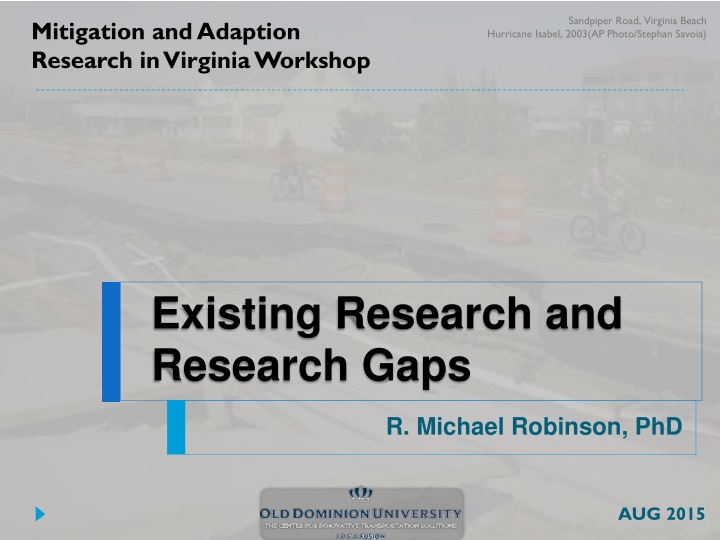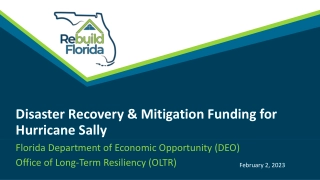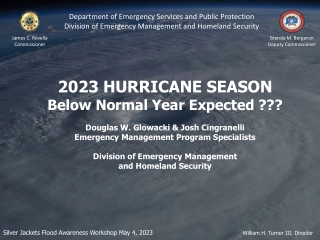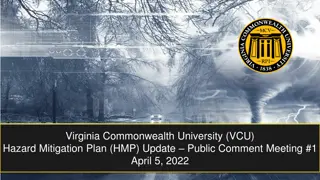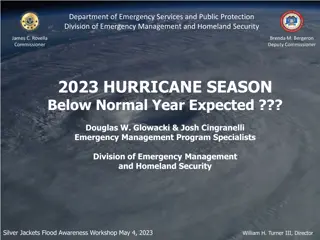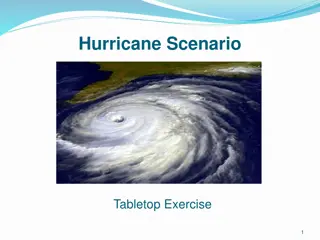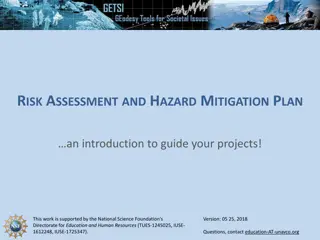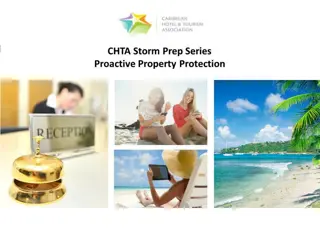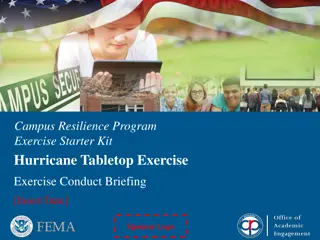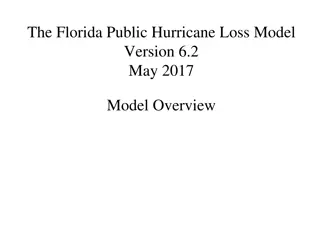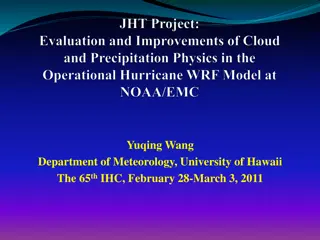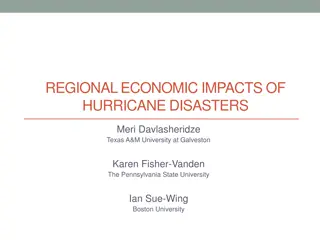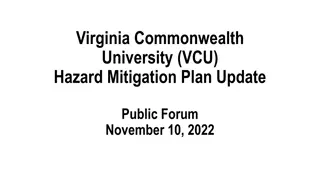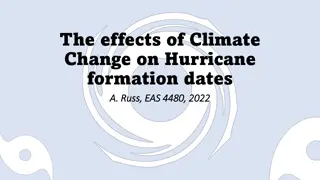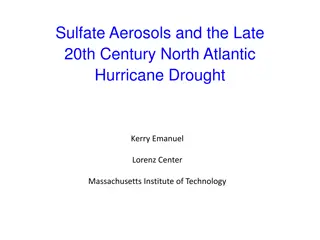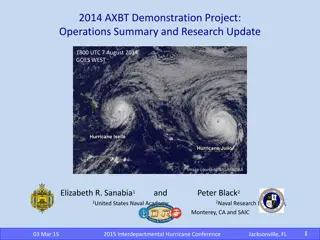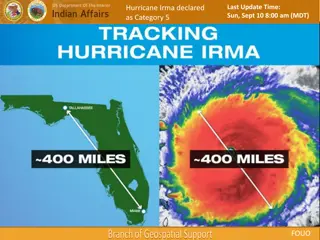Mitigation and Adaption Research in Virginia Workshop - Hurricane Isabel, 2003
Workshop overview discussing existing research and research gaps in various critical infrastructure sectors in Virginia following Hurricane Isabel in 2003. The research covers areas such as chemical manufacturing, commercial facilities, communications, critical manufacturing, dams, defense/industrial base, emergency services, energy, financial services, food and agriculture, government facilities, healthcare, information technology, nuclear, transportation systems, and water and wastewater.
Download Presentation

Please find below an Image/Link to download the presentation.
The content on the website is provided AS IS for your information and personal use only. It may not be sold, licensed, or shared on other websites without obtaining consent from the author.If you encounter any issues during the download, it is possible that the publisher has removed the file from their server.
You are allowed to download the files provided on this website for personal or commercial use, subject to the condition that they are used lawfully. All files are the property of their respective owners.
The content on the website is provided AS IS for your information and personal use only. It may not be sold, licensed, or shared on other websites without obtaining consent from the author.
E N D
Presentation Transcript
Sandpiper Road, Virginia Beach Mitigation and Adaption Research in Virginia Workshop Hurricane Isabel, 2003(AP Photo/Stephan Savoia) Existing Research and Research Gaps R. Michael Robinson, PhD AUG 2015
DHS Critical Infrastructures Chemical Commercial Facilities Communications Critical Manufacturing Dams Defense/Industrial Base Emergency Services Energy Financial Services Food & Agriculture Government Facilities Healthcare & Public Health Information Technology Nuclear Transportation Systems Water & Wastewater 2
What has been done? (1) Note: Work assessing the rate of sea level rise and extent of inundation is not included (key researchers are here) Chemical Very significant manufacturing in Mid-Atlantic Some manufacturing in Virginia CC/SLR related research in sector related to how industry could contribute to solution No research found on CC/SLR impact on sector Commercial Facilities Research related to CC/SLR cursory, related to flooded facilities and reduced access 3
What has been done? Communications CC/SLR could cause heat problems in service centers, exchanges, etc. and reduce wireless signal strength and quality Primary concern is the potential impacts failures could have on other infrastructures Resiliency planning in progress, but none identified in Mid-Atlantic Critical Manufacturing Very significant manufacturing in Mid-Atlantic Some in Virginia No CC/SLR related research in sector found (2) 4
What has been done? (3) Dams Approximately 50 hydroelectric plants in Mid-Atlantic, including 6 in Virginia Precipitation rate impacts Depending on location, could see either inadequate precipitation or excessive amounts No CC/SLR related research in sector found Defense Industrial Base Huge presence in Virginia Major impacts to local economies Most work being led within DOD. Limited published research. 5
What has been done? Emergency Services Capabilities and effectiveness directly related to transportation systems, communications, IT, etc. Increased demand resulting from higher temperatures, forecast storm frequency and intensity Alluded to in research of other areas, but little CC/SLR related research in sector found Energy Impacts due to rising temperatures, reduced water availability, increased storm rates and strengths Research being done, but none identified specifically in the Mid-Atlantic (4) 6
What has been done? Financial Services No CC/SLR related research in sector found Food & Agriculture Little consensus on significance of CC/SLR on changes to farm products, productivity Concerns about spread of disease, fungi, effectiveness of herbicides and insecticides at higher temperatures Government Facilities New construction design changes Extensive changes required to existing infrastructure (5) 7
What has been done? Healthcare and Public Health Emerging health threats as temperature changes allow existing threats to spread New demands on healthcare system Information Technology Potential major impacts due to heat in equipment centers Ubiquitous. Major concern is the potential impacts failures could have on other infrastructures Nuclear Reactors, Materials, and Waste Over a dozen plant sites in Mid-Atlantic Two commercial sites in Virginia (6) 8
What has been done? Transportation Existing CC/SLR related research focuses on flooding (reduced network capability) and environmental impacts on physical infrastructure Major impacts on other critical infrastructures (7) Water and Wastewater Weather changes impact type, rate, and timing of precipitation with significant downstream impacts Lack of downhill drainage Flooding impacts pump station viability 9
Sample Local City Considerations Hampton Infrastructure resiliency Transportation network viability Norfolk Residential area and business sector flooding Transportation network viability Port impacts Portsmouth Vulnerabilities Study Flood prone road network around military installations Virginia Beach Evacuation & SEPG considerations Beach resilience, tourism 10
Transportation Sector Example: Degradation & Strategic Investment Statewide spending has been unable to keep up with maintenance and improvements. Funding Needs Virginia roads rank 10th lowest in the nation for ride- ability 32nd nationally for the percent of bridges that are functionally obsolete or structurally deficient. SLR compounds this by Flooding evacuation routes Increasing hydraulic pressure on tunnels Altering drainage capacity Accelerating coastal erosion and damaging nearby roads 11
Interdependent Infrastructures Emergency Services Nuclear Energy Tax Revenue Commercial Facilities Transportation Systems Food & Agriculture Accessibility Government Facilities Chemical Sanitation & Logistics Healthy Workforce Information Technology Commun- ications Operational Support Accessibility Financial Services Critical Manufacturin g Sanitation Water & Wastewater Healthcare & Public Health Defense Industrial Base Healthy Workforce Dams 12
Interdependent Infrastructures Follow the Money! Causal Loop Diagram of interdependent population, commercial sector, &investment funding 13
Sample References (1) Abler, David G. and James S. Shortle. Climate change and agriculture in the Mid-Atlantic Region. Climate Research, Volume 14, pp. 185-194, 2000. (Considers how climate change might affect future Mid-Atlantic agriculture. Assessment suggests that Mid-Atlantic crop and livestock production will probably not change significantly though there maybe changes in the environmental impacts. Given that agriculture currently has significant negative impacts on water quality in many areas, including the Chesapeake Bay, this should be a high priority for research.) Assessing Vulnerability and Risk of Climate Change Effects on Transportation Infrastructure: Hampton Roads Virginia Pilot. (VDOT, UVA Center for Risk Management of Engineering Systems and Center for Transportation Studies, VCTIR, HRPDC, HRTPO). 2012. At: http://www.virginia.edu/crmes/fhwa_climate/files/finalReport.pdf Benson, Keith, Patricia Kocagil and James Shortle. Climate change and health in the Mid-Atlantic Region. Climate Research, Volume 14, pp. 235 244, 2000. (Assesses potential health impacts from climate change. Morbidity and mortality from extreme events may increase somewhat. Although more speculative, climate change could increase the region s risk from water-borne and vector-borne diseases. The elderly and those with limited access to health care could be disproportionately affected.) Fisher, Ann and Ron Smart (ed.). Climate Change Impacts in the Mid-Atlantic Region A Workshop Report. Sponsored by The U.S. Environmental Protection Agency, Office of Research and Development, Global Change Research Program (Cooperative Agreement No. CR 826554-01) and Office of Policy (Cooperative Agreement No. CR 824369-01) and The Pennsylvania State University, 1997. At: http://www.epa.gov/eims/global/ccimar.pdf. 14
Sample References (2) Ezell, Barry C., R. Michael Robinson, Peter Foytik, and David Flanagan. Cyber risk to transportation, industrial control systems and traffic signal controllers, Environment Systems and Decisions, November 2013, pp. 508-516. (A cyber risk study focusing on bridge/tunnel ICS and a cyber event that tampered with traffic signal operation.) Hampton Roads Transportation Planning Organization. Hampton Roads Military Transportation Needs Study: Roadways Serving the Military and Sea Level Rise/Storm Surge. July 2013. At: http://www.hrtpo.org/uploads/docs/Roadways%20Serving%20the%20Military%20&%20Sea%20Level%20Rise -Storm%20Surge%20Report.pdf Kleinosky, Lisa R., Brent Yarnal, and Ann Fisher. Vulnerability of Hampton Roads, Virginia to Storm-Surge Flooding and Sea-Level Rise. Natural Hazards, Volume 40, pp. 43-70, 2007. Neff, Rob, Heejun Chang, C. Gregory Knight, Raymond G. Najjar, Brent Yarnal, and Henry A. Walker. Impact of climate variation and change on Mid-Atlantic Region hydrology and water resources. Climate Research, Volume 14, pp. 207-218, 2000. (Observed streamflow, groundwater, and water-quality data are shown to vary in association with climate variation. Projections of future streamflow, groundwater, and water quality are made using models determined from these associations and are applied to 2 transient general circulation model (GCM) scenarios. Projections demonstrate that future hydrology and water resources will be influenced by climate change, but that uncertainty in accurately projecting that influence will continue until model scenarios improve.) 15
Sample References (3) Nichols, Keith M., HAMPTON ROADS CONGESTION MANAGEMENT PROCESS: THE STATE OF TRANSPORTATION IN HAMPTON ROADS 2014, June 2014. At: http://www.hrtpo.org/uploads/docs/State%20of%20Transportation%202014%20Final%20Report.pdf Rogers, Catriona E. and John P. McCarty. Climate change and ecosystems of the Mid-Atlantic Region. Climate Research, Volume 14, pp. 245 253, 2000.( Discusses status of forested, wetland, freshwater and coastal ecosystems; the combined impacts of habitat alteration, pollution and non-native invasive species on those systems; how climatic changes could interact with existing stresses; potential management strategies, and crucial research gaps in 2000.) Robinson, R. Michael, Barry Ezell, Peter Foytik, Craig Jordan, and Joseph Weiss. Cyber Risk to Transportation Industrial Control Systems. Journal of Cyber Security and Information Systems, Volume 1 Issue 4, October 2013, pp. 2-8. (Discusses and provides simulation case study results of consequences of cyber attack on transportation ICS, including estimates of commercial impact due to lost time in transit.) Stiles, William A. A Toolkit for Sea Level Rise Adaptation in Virginia. At: http://www.wetlandswatch.org/Portals/3/WW%20documents/sea-level-rise/ASCE%20Meeting%20Paper.pdf Tompkins, Forbes and Christina Deconcini. Sea-Level Rise and Its Impact on Virginia. World Resources Institute Fact Sheet. At: http://www.wri.org/sites/default/files/wri_factsheet_virginia_final.pdf 16
Sample References (4) Tran, Paul, LeonardWeireter, Whitney Sokolowski,Kaleen Lawsure, and John Sokolowski. HAZUS Modeling for Hurricane Effect on a Healthcare Campus: Implications for Health Care Planning. The American Surgeon, Volume 75,Number 11, November 2009, pp. 1059-1064(6). (Project modeled the damage sustained by the healthcare campus, in the aftermath of a hurricane, as a tool to facilitate pre- and post-storm planning for provision of healthcare services or campus evacuation. HAZUS was used to estimate disaster associated losses, storm surge, residual flooding, and wind damage. The ability of the healthcare campus to deliver services was assessed as a function of the residual functional infrastructure. ) 17
Mike Robinson rmrobins@odu.edu (757) 638-7010 18
Sandpiper Road, Virginia Beach Hurricane Isabel, 2003(AP Photo/Stephan Savoia) Discussion 19
